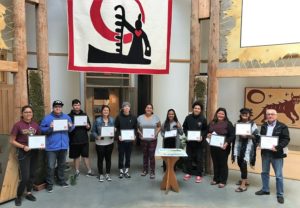Northern First Nations participate in Archaeological Monitor Training

By Sarah Hazell
This past summer, over 50 participants from 11 different First Nations were provided foundational archaeological training from the Ontario Archaeological Society (OAS). The training was made possible through an Ontario Trillium Foundation (OTF) grant that was awarded to the OAS to build archaeological capacity in northern Ontario First Nations over a two-year period. The first year of training resulted in the certification of 47 individuals, including youth, adults, and elders.
The OAS has a collaborative relationship with the Anishinabek Nation and worked directly with staff to identify potential communities. As a result of this liaising, Mississauga First Nation and Sagamok Anishnawbek expressed interest in participating, in addition to the Ojibwe Cultural Foundation (OCF) on Manitoulin Island. Between June and August of this summer, training was coordinated and conducted by Sarah Hazell (Nipissing First Nation) and Dr. Alicia Hawkins (OAS President), and workshop assistants Jake Cousineau and Griffin Assance-Goulais (Beausoleil First Nation). Training and modules were also facilitated by Sagamok Anishnawbek’s historian Allan Toulouse and Naomi Recollet of the Ojibwe Cultural Foundation, in addition to professional and academic member archaeologists of the OAS.
Participants were instructed in modules on Ontario archaeology, local archaeological culture history, research and professional archaeology, the Ministry of Tourism, Culture, and Sport (MTCS) Standards and Guidelines, the business of archaeology, Ontario heritage legislation, artifact identification, and test pitting (Stage 2). As an Indigenous archaeologist with over 20 years of experience, Sarah Hazell emphasised the importance of First Nations involvement in the recovery, analysis, and long-term curation of ancestral artifacts because 80% of identified archaeological sites in Ontario derive from Indigenous activities. Building archaeological capacity in northern communities enables First Nations to better engage with and advocate for heritage issues, from which they continue to be marginalized.
Regarding the training, Allen Toulouse highlighted the importance of Indigenous people telling our own stories to dismantle the negative impacts of the Doctrine of Discovery.
“An opportunity like this is very important especially given the way the narrative of how First Nations’ history is being told nowadays. It’s changed immensely even just the last 10 years, let alone if you were to look back 30 or 40 years ago, where the narrative was often to depict that Indigenous peoples of Canada were waiting to be discovered and that the bringers of civilization are just the settlers coming on over. Now, with this program, these kids know they can challenge these views that the Indigenous peoples that they come from are in fact a dynamic and engaged peoples who were in a constant state of adaptation during a greatly changing time.”
In addition to grant funded participants, First Nations requested the inclusion of employees from their Lands and Resources Departments demonstrating there is a strong demand to learn about archaeology and develop local capacity. To facilitate the success of the training, several nations also provided in-kind support in the form of food, transportation, and equipment.
While the majority of training occurred in class, each training included a day of archaeological fieldwork. Collaboratively, archaeologists Sarah Hazell and Alicia Hawkins worked with the communities to determine areas to be tested for archaeological significance. For instance, areas where concentrations of artifacts had been found in the past or areas that were slated for development.
When excavation of test pits produced artifacts, an Elder gave thanks to our ancestors by offering sacred semaa (tobacco) and placing some in the pit before refilling with soil. This practice was welcome by both participants and archaeologists to represent traditional Indigenous ways of being and knowing into the removal and collection of ancestor’s artifacts. It is the hoped that this practice of offering semaa and giving thanks will be adopted similarly by Ontario archaeologists as a sign of respect and reconciliation.
Naomi Recollet of the Ojibwe Cultural Foundation thought it was important to have the Elders and Knowledge Keepers be involved with the training since they provided important balance required to understand the importance of this type of work.
“We had two Elders present on the day of our site dig. If any artifacts or fragments were recovered and taken out from any of the holes that the students dug up, one of the Elders would say a prayer and offer semaa. When we removed the artifacts, we disrupted the connection it had formed with the land. So, each offering of semaa was to our ancestors that walked this land before us, to acknowledge them, to let them know of our intentions, that we are learning from them and that we still remember them.”
Caleb Nahwegahbow of Whitefish River First Nation said, “I really like the digging.” This was seconded by Paige Manitowabi, representing Wahnapitae First Nation and Wiikwemkoong Unceded Territory, who is actively pursuing additional archaeological training opportunities.
The training was an enormous success and included people from all walks of life: high school, college, university, and graduate students, adults pursuing continuing education, First Nation government employees, and Elders.
“The OAS is deeply honoured that 11 communities from northeastern Ontario have placed trust in our organization to help increase knowledge about the current practice of archaeology. We see this as a foundation for future collaborations,” expressed Alicia Hawkins, president of the OAS.

